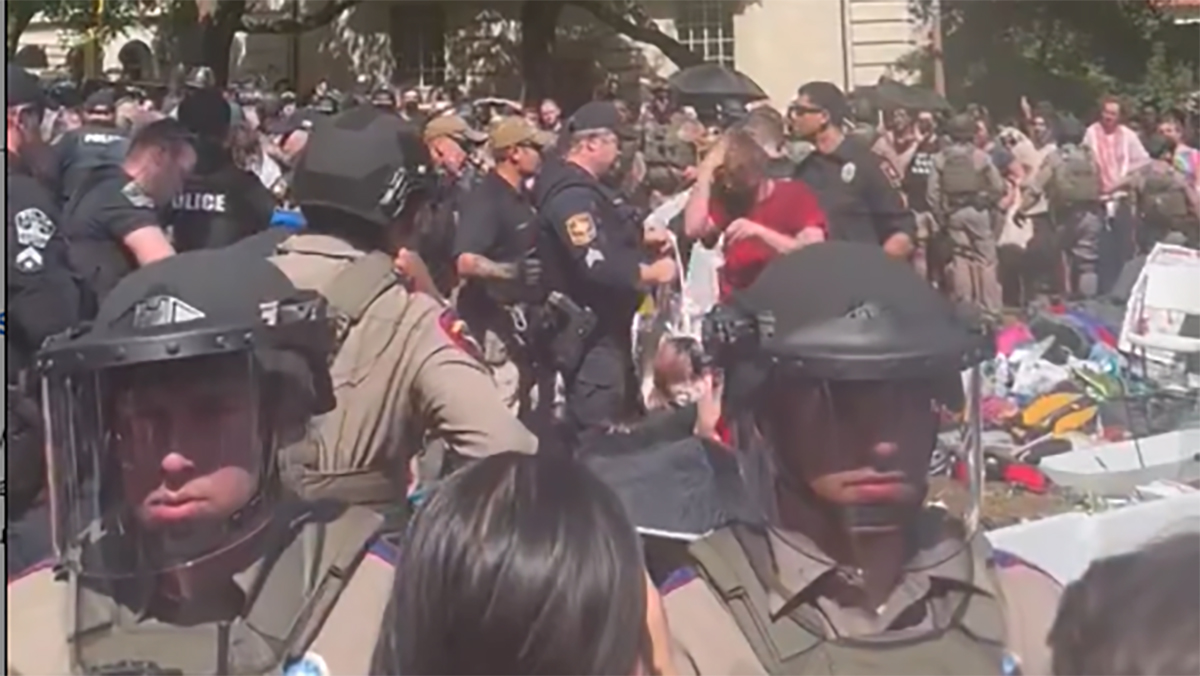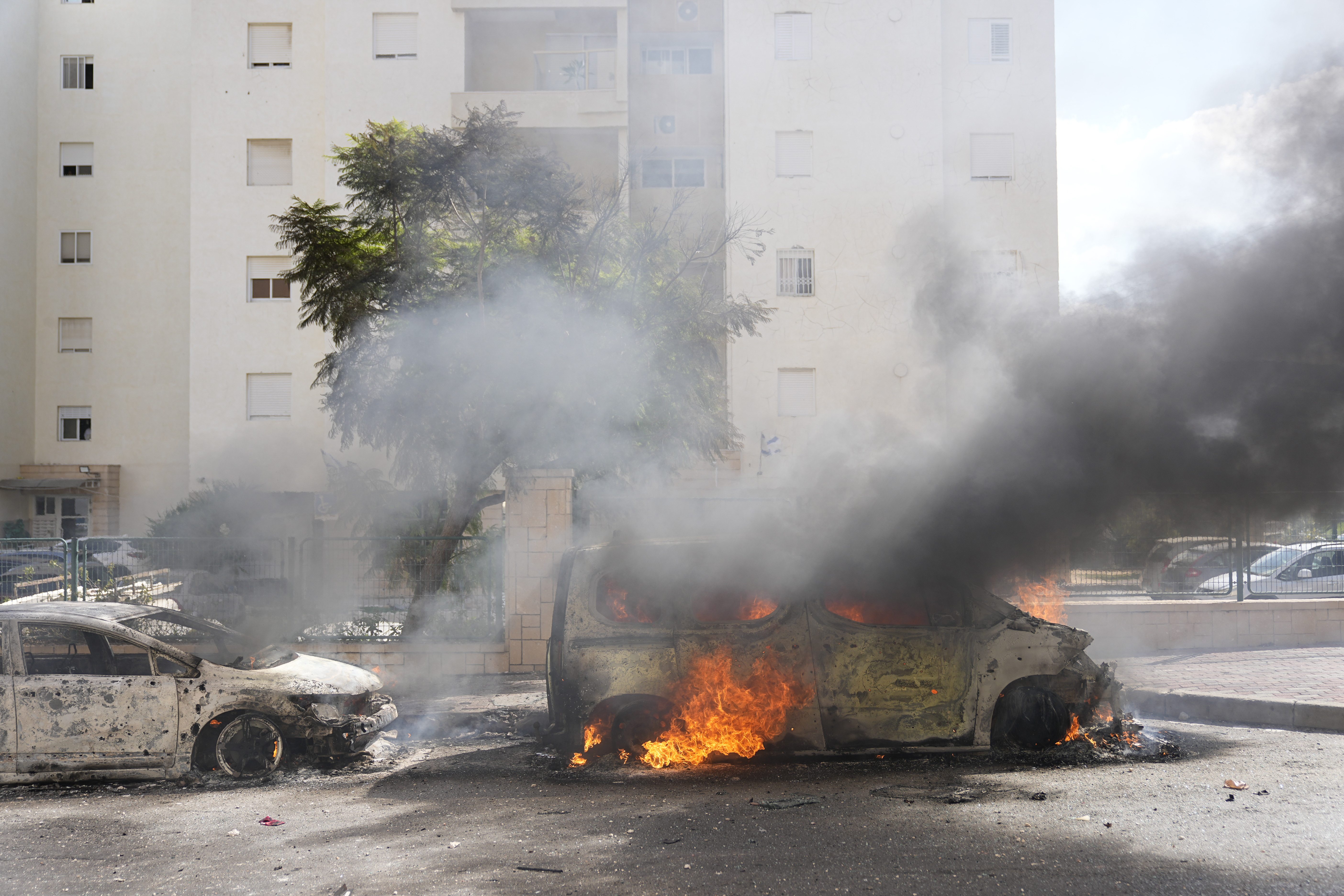Police cleared 30 to 40 people from inside Columbia University's Hamilton Hall late Tuesday after pro-Palestinian protesters occupied the administration building in New York earlier in the day.
The scene unfolded shortly after 9 p.m. as police, wearing helmets and carrying zip ties and riot shields, massed at the college's entrance. Scores of officers climbed through a window to enter the occupied building, streaming in over a ramp raised from the top of a police vehicle to get inside. Multiple protesters were taken into custody and taken away from campus on buses.
In all, nearly 100 people were arrested during Tuesday's confrontation, with about 40 of them coming from inside the building, an NYPD spokesperson told NBC News. Hamilton Hall was cleared by police just before 11 p.m.
The confrontation occurred more than 12 hours after the demonstrators took over Hamilton Hall shortly after midnight Tuesday, spreading their reach from an encampment elsewhere on the grounds that’s been there for nearly two weeks to protest the Israel-Hamas war. The police action happened on the 56th anniversary of a similar police action to quash an occupation of Hamilton Hall by students protesting racism and the Vietnam War.
The university, in a statement issued after the police entered the campus, described its decision to seek NYPD aid as a last resort. The police department had previously said officers wouldn't enter the grounds without the college administration’s request or an imminent emergency. Now, law enforcement will be there through May 17, the end of the university's commencement events.
“After the University learned overnight that Hamilton Hall had been occupied, vandalized, and blockaded, we were left with no choice,” the school's statement said, adding that school public safety personnel were forced out of the building and one facilities worker was “threatened.”
“The decision to reach out to the NYPD was in response to the actions of the protesters, not the cause they are championing," the statement said. "We have made it clear that the life of campus cannot be endlessly interrupted by protesters who violate the rules and the law.”
Columbia's protests earlier this month kicked off demonstrations that now span from California to Massachusetts. As May commencement ceremonies near, administrators face added pressure to clear protesters.
More than 1,000 protesters have been arrested over the last two weeks on campuses in states including Texas, Utah, Virginia, North Carolina, New Mexico, Connecticut, Louisiana, California and New Jersey, some after confrontations with police in riot gear.
Get a weekly recap of the latest San Francisco Bay Area housing news. >Sign up for NBC Bay Area’s Housing Deconstructed newsletter.
Tuesday’s police action at Columbia comes exactly 56 years after officers swept into Hamilton Hall to arrest protesters occupying the building in 1968. The students taken into custody on that April 30 had taken over the hall and other campus buildings for a week to protest racism and the Vietnam War.
Former President Donald Trump called into Sean Hannity’s show on Fox News Channel to comment on Columbia's turmoil as live footage of police clearing Hamilton Hall aired. Trump praised the officers.
“But it should never have gotten to this," he told Hannity. "And they should have done it a lot sooner than before they took over the building because it would have been a lot easier if they were in tents rather than a building. And tremendous damage done, too.”
In a letter to senior NYPD officials, Columbia President Minouche Shafik said the administration was making the request that police remove protesters from the occupied building and a nearby tent encampment “with the utmost regret.”
Earlier in the day, New York City Mayor Eric Adams advised the protesters to leave before police arrived.
Photos: Pro-Palestinian demonstrations on US college campuses
“Walk away from this situation now and continue your advocacy through other means,” he said. “This must end now.”
Before officers arrived, the White House condemned the standoffs at Columbia and California State Polytechnic University, Humboldt, where protesters had occupied two buildings until officers with batons intervened overnight and arrested 25 people. Officials estimated the northern California campus' total damage to be upwards of $1 million.
President Joe Biden believes students occupying an academic building is “absolutely the wrong approach,” and “not an example of peaceful protest,” said National Security Council spokesperson John Kirby.
Other colleges have sought to negotiate agreements with the demonstrators in the hopes of having peaceful commencement ceremonies. As cease-fire negotiations appeared to gain steam, it wasn’t clear whether those talks would inspire an easing of protests.
Northwestern University notched a rare win when officials said they reached a compromise with students and faculty who represent the majority of protesters on its campus near Chicago to allow peaceful demonstrations through the end of spring classes.
The nationwide campus protests began at Columbia in response to Israel’s offensive in Gaza after Hamas launched a deadly attack on southern Israel on Oct. 7. Militants killed about 1,200 people, most of them civilians, and took roughly 250 hostages. Vowing to stamp out Hamas, Israel has killed more than 34,000 Palestinians in the Gaza Strip, according to the local health ministry.
Israel and its supporters have branded the university protests as antisemitic, while Israel’s critics say it uses those allegations to silence opposition. Although some protesters have been caught on camera making antisemitic remarks or violent threats, organizers of the protests, some of whom are Jewish, say it is a peaceful movement aimed at defending Palestinian rights and protesting the war.
On Columbia’s campus, protesters first set up a tent encampment almost two weeks ago. The school sent in police to clear the tents the following day, arresting more than 100 people, only for the students to return – and inspire a wave of similar encampments at campuses across the country.
Negotiations between the protesters and the college came to a standstill in recent days, and the school set a deadline for the activists to abandon the tent encampment Monday afternoon or be suspended.
Instead, protestors defied the ultimatum and took over Hamilton Hall early Tuesday, carrying in furniture and metal barricades. The demonstrators dubbed the building Hind’s Hall, honoring a young girl who was killed in Gaza under Israeli fire, and issued demands for divestment, financial transparency and amnesty.
The Columbia University Chapter of the American Association of University Professors said faculty’s efforts to help defuse the situation have been repeatedly ignored by the university’s administration despite school statutes that require consultation.
Ilana Lewkovitch, a self-described “leftist Zionist” student at Columbia, said it’s been hard to concentrate on school for weeks, amid calls for Zionists to die or leave campus. Her exams have been punctuated with chants of “say it loud, say it clear, we want Zionists out of here” in the background, she said.
Lewkovitch, who identifies as Jewish and studied at Columbia’s Tel Aviv campus, said she wished the current pro-Palestinian protests were more open to people like her who criticize Israel’s war policies but believe there should be an Israeli state.
Adams claimed Tuesday that the Columbia protests have been “co-opted by professional outside agitators.” The mayor didn’t provide specific evidence to back up that contention, which was disputed by protest organizers and participants.
NYPD officials made similar claims about “outside agitators” during the huge, grassroots demonstrations against racial injustice that erupted across the city after the death of George Floyd in 2020. In some instances, top police officials falsely labeled peaceful marches organized by well-known neighborhood activists as the work of violent extremists.



